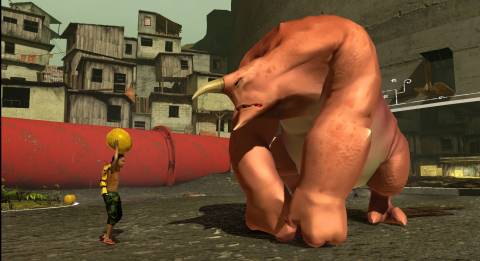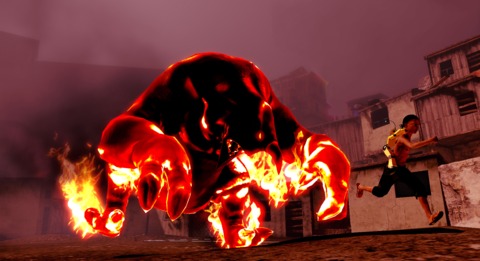I don't think its unfair to say that personal expression plays a huge part in any successful artistic creation. Whether it's a film, music, or literature, many of our most revered talents poured much of themselves into the works that made them so recognizable. So why do we not necessarily expect the same of games? Without diving into that obnoxious, self-indulgent argument of whether or not games can be Art, one can simply say that for many, many years, games have been seen by many--including some of those who help make them--as purely fluff entertainment. Sure, our best games have often come from designers who injected a bit of themselves into what you ended up playing, but outside of a few rare cases, most games have seemed largely content to be viewed as simple entertainment software, meant to be purchased, consumed, and essentially left behind once the next big thing comes along.

Papo & Yo isn't content to be mere software. As the debut game from indie studio Minority Media and its founder, Vander Caballero, Papo & Yo explores themes often left to "heavier" entertainment media, but does so in a way that tries to marry whimsical, childlike fantasy to its tragic underpinnings. When it works, Papo & Yo is unlike anything I've played before, a heartfelt allegory of a painful childhood experience depicted in equal measure with traditional storytelling and the mechanics of gameplay. Unfortunately, there are as many instances where Papo & Yo doesn't quite work, where the metaphors and the mechanics don't sync up, leaving the player in stilted, awkward circumstances that disengage you from the experience.
Few of those issues rear their head in the game's early goings, where you are introduced to Quico, a South American boy who finds himself in a strange, fantastical world. Though this world features many of the abject elements of slum life, Quico is surprisingly adept at manipulating it. More on that later.
Quico is joined by a pair of strange friends. Lula is a sentient toy robot who periodically helps out with solving puzzles, while Monster is precisely what he sounds like. The pink-skinned, multi-horned Monster is a peculiar creature. At times, he's a little like Labyrinth's lumbering Ludo, a simple-minded but pleasant giant that tags along for the ride. At others, he's a literal flaming psychopath, hellbent on attacking anything in his path.
Caballero has made no secret that Quico and Monster's relationship is based upon his own relationship with his father, who was an abusive alcoholic. In this case, Monster is addicted to frogs. He eats them, and suddenly his demeanor shifts from chummy to enraged. Your task as Quico is to find ways to push the decidedly lazy Monster through the game's world while simultaneously trying to manage and hopefully cure his addiction.

It's not often you're faced with an allegory as heavy as that when playing a video game. Undoubtedly the process of trying to combine such barbed themes with a world and play style that effectively takes some of the stinging edge off is a complicated one. To try and tackle this, Minority has crafted Papo & Yo as a lightweight puzzle platformer, rooted in simple jumping and switch-finding puzzles that don't so much challenge as briefly distract.
The puzzles are meant to be unobtrusive to the player, but in their simplicity, unintended complications arise. This is especially true of the game's middle sections, which rely more on the puzzle solving elements than the narrative. Throughout the game, you follow around a mysterious girl who may or may not have the key to solving Monster's ills. She draws doors, switches, gears, and all manner of other gadgetry on the walls in chalk outlines. These chalk outlines become three-dimensional objects somehow, and Quico is able to manipulate them.
Trouble is, that's really all Quico has to do. You enter a level, see the highlighted sections that need to be interacted with, and pretty much just do that until you're out of things to interact with. The only real challenge before you is jumping up to those places. Not because the jumps are difficult to parse, but because the controls are simply too loose to jump anywhere with precision. The whole purpose of Papo & Yo's simplistic design seems to be to keep the player focused on the world around them, but the loose handling forces the player to focus for all the wrong reasons. Instead of taking in the details of the environment, you're hyperfocused on some ledge or rooftop that you keep missing because the controls can't easily get you there.
Technical glitches and bugs have a tendency to get in the way as well. The frame rate can be dodgy, and there's no shortage of screen-tearing glitches to be found, but those are the kinds of forgivable things you can ignore when you're truly engaged with a game. Less forgivable are the bugs that sometimes take you right out of the game and force you to restart progress. Some of the bugs I experienced were fixed via a day-one patch, but others stuck around, including a couple of reproduceable world progress glitches that required a restart to fix.
These issues are less of a problem in the early and late goings of Papo & Yo, because these are the areas where the puzzle-solving largely gives way to the story. Caballero once told me in an interview that his ultimate goal was to tell his stories using mechanics, and in these sections, the story is told effectively. Quico's exploration of his imaginary world effortlessly blends into the gameplay, mixing metaphors and interactivity in a way that's simply beautiful. It's especially true of the end, which I will only say provides a pointed, heartbreaking catharsis to the events that have come before.

This is not a game afraid to hide its pain, though it does occasionally have issues expressing that pain with clarity. It's something that nagged at me throughout Papo & Yo, specifically the relationship between Quico and Monster. Monster, by all appearances, is meant to be a friendly character, someone that Quico loves and shows affection toward. However, the game's story doesn't always use this relationship to great effect. Too often Monster is simply a tool you use to get to the next level section, or something you have to calm down to avoid injury. While there are moments where Monster will occasionally step in to rescue Quico from some peril, too often Monster feels like a means to an end, rather than a full-fledged character to attach to. He's less a best friend than a looming, undefined presence. It's possible that's true to Caballero's experience with his father, but without a more identifiable attachment to Monster, it's tougher than it ought to be to connect with the emotions the story actively pushes you toward.
Which isn't to say you won't be affected by it at all. It might not dig as deep as it seemingly could have, and the technical issues are perhaps a bit too prevalent to ignore, but in an age where indie games are finally beginning to bloom as a way to experiment with narrative, Papo & Yo still feels like a brave step forward into uncharted territory. And as with all first steps, it's something of a clumsy one, perhaps unsure of itself and its own limitations. Caballero and his team have crafted something in Papo & Yo that I believe is a wholly worthwhile experience, if not an entirely successful one. They've shown that they lack neither the creativity nor the conviction to push gaming to more personal, more uncomfortable spaces. And even if the first fruit of that labor turned out flawed, the ideas behind it are still worth cheering for.